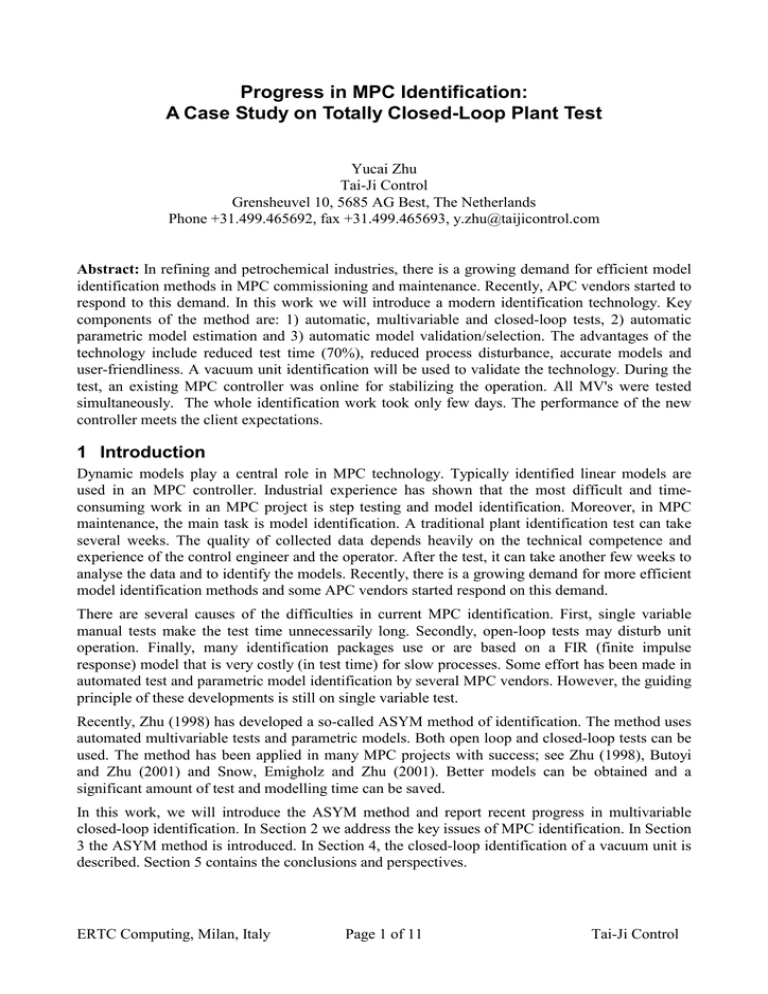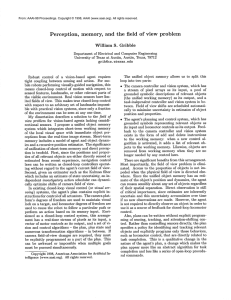Progress in MPC Identification: A Case Study on Totally Closed
advertisement

Progress in MPC Identification: A Case Study on Totally Closed-Loop Plant Test Yucai Zhu Tai-Ji Control Grensheuvel 10, 5685 AG Best, The Netherlands Phone +31.499.465692, fax +31.499.465693, y.zhu@taijicontrol.com Abstract: In refining and petrochemical industries, there is a growing demand for efficient model identification methods in MPC commissioning and maintenance. Recently, APC vendors started to respond to this demand. In this work we will introduce a modern identification technology. Key components of the method are: 1) automatic, multivariable and closed-loop tests, 2) automatic parametric model estimation and 3) automatic model validation/selection. The advantages of the technology include reduced test time (70%), reduced process disturbance, accurate models and user-friendliness. A vacuum unit identification will be used to validate the technology. During the test, an existing MPC controller was online for stabilizing the operation. All MV's were tested simultaneously. The whole identification work took only few days. The performance of the new controller meets the client expectations. 1 Introduction Dynamic models play a central role in MPC technology. Typically identified linear models are used in an MPC controller. Industrial experience has shown that the most difficult and timeconsuming work in an MPC project is step testing and model identification. Moreover, in MPC maintenance, the main task is model identification. A traditional plant identification test can take several weeks. The quality of collected data depends heavily on the technical competence and experience of the control engineer and the operator. After the test, it can take another few weeks to analyse the data and to identify the models. Recently, there is a growing demand for more efficient model identification methods and some APC vendors started respond on this demand. There are several causes of the difficulties in current MPC identification. First, single variable manual tests make the test time unnecessarily long. Secondly, open-loop tests may disturb unit operation. Finally, many identification packages use or are based on a FIR (finite impulse response) model that is very costly (in test time) for slow processes. Some effort has been made in automated test and parametric model identification by several MPC vendors. However, the guiding principle of these developments is still on single variable test. Recently, Zhu (1998) has developed a so-called ASYM method of identification. The method uses automated multivariable tests and parametric models. Both open loop and closed-loop tests can be used. The method has been applied in many MPC projects with success; see Zhu (1998), Butoyi and Zhu (2001) and Snow, Emigholz and Zhu (2001). Better models can be obtained and a significant amount of test and modelling time can be saved. In this work, we will introduce the ASYM method and report recent progress in multivariable closed-loop identification. In Section 2 we address the key issues of MPC identification. In Section 3 the ASYM method is introduced. In Section 4, the closed-loop identification of a vacuum unit is described. Section 5 contains the conclusions and perspectives. ERTC Computing, Milan, Italy Page 1 of 11 Tai-Ji Control 2 Key Issues in MPC Identification Hydrocarbon processes can be characterised as 1) large scale and complex, 2) dominant slow dynamics and 3) high level disturbances. These characteristics require special attention in process model identification. The discussion will be around the four problems of identification: test design, parameter estimation, model structure and order selection, and model validation. 1) Plant Test; Single Variable or Multivariable, Open Loop or Closed-Loop? The current practice of the MPC industry is to use a series of open loop and single-variable step tests. The tests are carried out manually. The advantage of this test method is that control engineer can watch many step responses during the tests and can learn about the process behaviour in an intuitive manner. The problems with single variable step tests are: 1) the high cost in time and in manpower; 2) the data from a single variable test may not contain good information about the multivariable character of the process (ratios between different models) and step signals do not provide sufficient excitement of the dynamic character of the process; and 3) an open loop test may disturb unit operation and require corrective moves. Using automatic multivariable closed-loop testing can solve the problems. There are many advantages of a multivariable closed-loop test: • Reduce the disturbance to unit operation. In a closed-loop test, the controller will help to keep the CV’s within their operational limits. • Easier to carry out. In an automatic multivariable closed-loop test, much less engineer or operator intervention is needed. Night shifts could be avoided. • Better model for control. This can be explained in several ways. Under the same CV variance constraints, the model from a closed-loop test data will have higher control performance than the model from an open loop test; see Gevers and Ljung (1986) and Hjalmarsson et. al. (1996). The feedback will have additional advantage if the process is ill-conditioned meaning that several CV’s are strongly correlated such as in high purity distillation columns. For the control of ill-conditioned processes, it is important to identify the model that has good estimate of the difference or ratios between the CV’s, or, the low-gain direction. In order to amplify the power of low-gain direction, strong correlation between MV movements is needed. This correlation can be created naturally by feedback control; see Koung and MacGregor (1993) and Jacobsen (1994). In MPC development, a partial closed-loop test can be used. One or more PID loops can be used in a partial closed-loop test. Typical examples of these loops are: top and bottom compositions, temperatures (pressure compensated), and levels. In MPC maintenance, the existing MPC may still work reasonably well. It could be used for the test. Some researchers and engineers have mistakenly believed that the process is only identifiable when an open loop test is performed and when MV’s are moved independently. It has been shown a long time ago that, if persistent excitation signals are added on the MV’s and/or on the CV setpoints, the process will be identifiable in a closed-loop test; see Gustavsson et. al. (1977). It is true that some model structures and estimation methods will be biased and not consistent if used for closed-loop identification; see Ljung (1987). 2) Model Structure and Parameter Estimation Given a multivariable process with m manipulated variables (MV’s or inputs) and p controlled variables (CV’s or outputs). A general linear process model can written as ERTC Computing, Milan, Italy Page 2 of 11 Tai-Ji Control y (t ) = G ( z −1 )u(t ) + H ( z −1 )e(t ) (2.1) where u(t) is m-dimensional input vector (MV’s), y(t) is p-dimensional output vector (CV’s) and N is the number of samples, z-1 is the unit time delay operator, G(z-1) is the process transfer function matrix, H(z-1) is the noise filter and e(t) is a p-dimensional white noise vector. The term H(z-1)e(t) represents the unmeasured disturbances acting at the process outputs. Depending on how we parameterise the model in (2.1), different parameter estimation methods in the literature can be derived. FIR (finite impulse response) model nb y (t ) = B( z −1 )u (t ) + e(t ) = (¦ Bk z −k )u (t ) + e(t ) (2.2) k =0 where Bk is a constant matrix. Box-Jenkins model y (t ) = A −1 ( z −1 ) B( z −1 )u (t ) + D −1 ( z −1 )C ( z −1 )e(t ) (2.3) where A( z −1 ) , B( z −1 ) , C ( z −1 ) and D( z −1 ) are polynomial matrices. The model parameters are determined by minimising the sum of squares of the error e(t). In literature, the Box-Jenkins model is called a parametric model and the FIR model a nonparametric model. The difference between the two types of models is that parametric models are much more compact than nonparametric models and need much fewer parameters to describe the same dynamic behaviour. Subspace method In recent years, the so-called subspace method of parameter estimation has been proposed and studied in the literature; see van Overschee and de Moor (1994), Verhaegen (1994) and Larimore (1990). Subspace methods estimate a state space model of a multivariable process directly from input/output data. When noisy data is used in the identification, a compact model will be more accurate provided that the parameter estimation algorithm converges to global minimum and the model order is selected properly. In general, a model structure that includes a disturbance model will be better than a method without the disturbance model; see Ljung (1999). Prediction error criterion used in BoxJenkins model belong to the first class; while the output error criterion used by the FIR model belongs to the second class. Moreover, the prediction error method will give consistent estimates for closed-loop data meaning that the effect of the disturbance will decrease when test time increases. The output error criterion will deliver biased models when using closed-loop data. However, a more compact model needs more complex parameter estimation algorithms. To estimate a Box-Jenkins model, nonlinear optimisation routines are needed which often suffer from local minima and convergence problems when identifying a multivariable process. State space models used in subspace methods are parametric models. There several numerically efficient methods to estimate the models in subspace methods. In general, the accuracy of models obtained from subspace is not as high as those obtained from prediction error methods. Model consistency for closed-loop data is not yet established. 3) Order Selection In the identification literature, when prediction error is used in parameter estimation, it is also used in order selection. We will argue that, although prediction error is a good choice for parameter ERTC Computing, Milan, Italy Page 3 of 11 Tai-Ji Control estimation, it is not the best criterion for order selection for control. For the purpose of control, it is most important to select the model order so that the process model G ( z −1 ) is most accurate. 4) Model Validation The goal of model validation is to test whether the model is good enough for its purpose and to provide advice for possible re-identification if the identified model is not valid for its intended use. Commonly used methods of model validation are: simulation using estimation data or fresh data, doing a whiteness test of model residuals, and testing the independence between the residuals and past MV’s. These methods only tell how well the model agrees with the test data. They can neither quantify the model quality with respect to control, nor can they give good advice for reidentification. Simulation is a common validation tool in many industrial packages. This approach is very questionable for closed-loop data, because it is known that it is very easy to fit measured CV’s with simulated CV’s when there is no persistent excitation and the model converges to the inverse of the controller rather than to the process. 3 Tai-Ji ID Tai-Ji ID is an identification software package that carries out identification automatically from test design to model validation. Tai-Ji ID is based on the so-called ASYM method that uses parametrical models, automated multivariable closed-loop test (open loop test is also possible) and new way of model validation. See Zhu (1998, 2001). 1) Identification Test The following are important features of the Tai-Ji ID test: 2) a) Duration of identification test. The planned test time is related to the process settling time and to the number of MV’s. The final test time is determined by model validation. When compared with the traditional step test approach, 70% test time can be saved using this approach. Note that the test time may not be long enough for nonparametric FIR models, because the identification of nonparametric models requires a much longer test. b) Closed-loop test. Often some CV’s are sensitive and have tight constraints. In this situation, closed-loop testing will be used with these CV’s controlled by some single loop PID controllers. When an MPC controller exists which still does a reasonably good job, though no longer optimal, one can test the process while keeping the MPC on. One can also perform a partial closed-loop test using an MPC with part of the MV’s and CV’s on. Experience has shown that closed-loop tests reduce disturbance to unit operation and at the same time increase the information content in data. c) Optimal design of test signal spectra. The guideline is to put the energy of the test signal at frequencies where the model will be used and where disturbance level is high (Ljung, 1985 and Zhu 2001). The spectra of the test signals are approximated using GBN (generalised binary noise) signals (Tulleken, 1990). Parameter Estimation First a high order ARX (equation error) model is estimated. Then a frequency domain model reduction is used to arrive at a low order model. The final model is in a Box-Jenkins form. See Zhu (1998, 2001) for details. 3) Use asymptotic criterion for order selection ERTC Computing, Milan, Italy Page 4 of 11 Tai-Ji Control The best order of the reduced model is determined using a frequency domain criterion ASYC which is related naturally to the noise-to-signal ratios and to the test time; see Zhu (1998). The basic idea of this criterion is to minimize the total model error by equalizing the bias error and the variance error of each transfer function in the frequency range that is important for control. 4) Model validation using error bound matrix Based on an asymptotic theory (Ljung 1985 and Zhu 1998), a 3-σ bound can be derived for the model frequency response between ith CV and jth MV. In model validation, the relative size of the error bound is compared with the model frequency response over the low and middle frequencies. Then each transfer function is graded either an A (very good), B (good), C (marginal) and D (poor). In general, A and B models can be used in MPC control and C and D models should be treated as follows: 1) Zero them when there is no transfer between the MV/CV pairs. This can be determined by using process knowledge and cross checking. 2) If a transfer function is expected and needed in the control, adjust the test in order to improve the accuracy of these models. Using the upper bound formula, one can easily give guidelines for improving the test design. All the four steps are carried out automatically in Tai-Ji ID. 4 Closed-Loop Identification of a Vacuum Unit The unit is a lube distillation unit composed of a preheat train, fired heater and a vacuum distillation column with 5 side draws. The column produces from top to bottom a vacuum gas oil, 4 distillates and a vacuum residue. The unit belongs to a refinery of a major European oil company. The MPC controller has 8 MV’s, 2 DV’s and 25 CV’s. Its goal is to maximise feed rate, the most valuable distillate yield and maintain all the distillate qualities within their ranges. The controller also takes care of the diverse hydraulic and fire heater constraints. The MPC controller has been commissioned using the traditional step test method. The step test lasted about 12 days around the clock. The MPC controller overall performance was correct but enhance able. To do better, a pilot project based on Tai-Ji ID methodology was initiated at the oil company. TaiJi ID was used to identify the vacuum unit model for the MPC controller. Because the heart of the controller consists of six MV’s, these MV’s will be tested and their models identified. Before starting the test, the MPC controller was online with the six MV’s turned on. All the six MV’s were moved by the GBN signals; some of the CV setpoints are also moved by the GBN signals. After about 20 hours of test, MV/CV data were collected and models were identified using Tai-Ji ID. Some MV step sizes were adjusted according to model validation. After about 48 hours of test, identification and model validation were carried out again. The results of model validation showed that all expected models were with good qualities. The test was stopped at 52 hours. ERTC Computing, Milan, Italy Page 5 of 11 Tai-Ji Control Vacuum System TPA Vacuum Gas Oil Fresh Feed MPA Distillate 1 Distillate 2 Distillate 3 Distillate 4 Residue Figure 4.1 Simplified flow diagram of the vacuum unit The test was driven not to disturb normal unit operation. Test data and identification results are shown in Figures 4.2 – 4.7. The following were the findings of Tai-Ji ID identification and controller tuning: • The obtained models agree with process knowledge and they were qualitatively similar to the existing models used in the MPC controller. This confirmed the fact that good models can be obtained from closed-loop data. • On the other hand, there are differences between the two models. The original controller sometimes overreacts on disturbances and on limit changes. This was very likely caused by underestimating some model gains; process knowledge pointed to the same direction. It was also believed that some secondary models were missing in the original controller. Indeed, Tai-Ji ID model has, in general, larger gains than those of the original model. Moreover, two additional models were identified that were missing in the original models. See Figure 4.7. • The new model was implemented in the MPC controller and the control performance became better. Namely, the controller were tuned a little bit faster and the controller shows more stable behaviour. • Based on both model comparison and controller performance, it was believed that Tai-Ji ID model has higher control quality than the original model. ERTC Computing, Milan, Italy Page 6 of 11 Tai-Ji Control Figure 4.2 MV signals during the closed-loop test. Data are normalized. Figure 4.3 Part of the CV signals during the closed-loop test. Data are normalized. ERTC Computing, Milan, Italy Page 7 of 11 Tai-Ji Control Figure 4.4 Model step responses. Data are normalized. Figure 4.5 Frequency responses and error bounds. Data are normalized. ERTC Computing, Milan, Italy Page 8 of 11 Tai-Ji Control Figure 4.6 Measured and simulated CV’s. Data are normalized. ERTC Computing, Milan, Italy Page 9 of 11 Tai-Ji Control Figure 4.7 Model comparisons (part of the model). Green lines are the step responses of the original model; red (smooth) lines are those of Tai-Ji ID model. Tai-Ji ID found two additional models. 5 Benefits and Discussion There is a growing demand for a more efficient MPC identification technology. The vacuum unit application shows that the Tai-Ji ID method worked well in close-loop with an MPC controller. Therefore, the customer foresees other projects using this technology. We have shown that the efficiency of MPC identification can be increased by a factor of 3 and model quality can be improved. At the same time, the disturbance of plant test to unit operation and the workload of control engineers can be reduced. Important steps taken in the method are: 1) The use of automated, multivariable and closed-loop plant test; 2) the use of correlated MV data; 3) the use of low order parametric (compact) models; and 4) the use of automated identification/validation procedure. Traditionally, most of these steps were considered prohibitive among MPC control engineers. This has caused some fear in using modern technologies. Successes with closed-loop tests show the possibility to reduce overall plant test period and may be some tasks during night shifts. This will further reduce the cost of manpower. Moreover, good experience with the automated test and identification is pointing at the feasibility of self-adaptive identification. References Cutler, C.R. and R.B. Hawkins (1988). Application of a large predictive multivariable controller to a hydrocracher second stage reactor. Proc. of American Control Conference, pp. 284-291. Butoyi, F. and Y. Zhu (2001). Increase efficiency of model predictive control using multivariable closed-loop identification. Hydrocarban Processing, March 2001. Gustavsson I., L. Ljung and T. Söderström (1977). Identification of processes in closed loop — identifiability and accuracy aspects. Automatica, Vol. 13, pp. 59-75. Hjalmarsson, H., M. Gevers, F. de Bruyne (1996). For model-based control design, closed-loop identification gives better performance. Automatica, Vol. 32, No. 12, pp. 1659-1673. Jacobsen, E.W. (1994). Identification for Control of Strongly Interactive Plants. Paper 226ah, AIChE Annual Meeting, San Francisco. Koung, C.W. and J.F. MacGregor (1993). Design of identification experiments for robust control. A geometric approach for bivariate processes. Ind. Eng. Chem. Res., Vol. 32, pp. 1658-1666. Larimore, W.E. (1990). Canonical variable analysis in identification, filtering and adaptive control. Proc. of 29th IEEE Conference on Decision and Control, Honolulu, Hawaii, pp. 596-604. Ljung, L. (1985). Asymptotic variance expressions for identified black-box transfer function models. IEEE Trans. Autom. Control, Vol. AC-30, pp. 834-844. Ljung. L. (1999). System Identification: Theory for the User. Second Edition. Prentice-Hall, Englewood Cliffs, N.J. Richalet, J. (1993). Industrial applications of model based predictive control. Automatica, Vol. 29, No. 5, pp. 1251-1274. Snow, W.P., K.F. Emigholz and Y.C. Zhu (2001). Increase MPC Project Efficiency by using a Modern Identification Method. ERTC Computing, 18-20 June, 2001, Paris. Tulleken, H.J.A.F. (1990). Generalized binary noise test-signal concept for improved identification-experiment design. Automatica, Vol. 26, No. 1, pp. 37-49. Van Overschee, P. and B. De Moor (1994). N4SID: subspace algorithms for the identification of combined deterministic-stochastic systems. Automatica, Vol. 30, No. 1, pp. 75-93. Verhaegen, M. (1994). Identification of the deterministic part of MIMO state space models given in innovations form from input-output data. Automatica, Vol. 30, No. 1, pp. 61-74. ERTC Computing, Milan, Italy Page 10 of 11 Tai-Ji Control Zhu, Y.C. (1998). Multivariable process identification for MPC: the asymptotic method and its applications. Journal of Process Control, Vol. 8, No. 2, pp. 101-115. Zhu, Y.C. (2001). Multivariable System Identification for Process Control. Elsevier Science, Oxford. ERTC Computing, Milan, Italy Page 11 of 11 Tai-Ji Control




